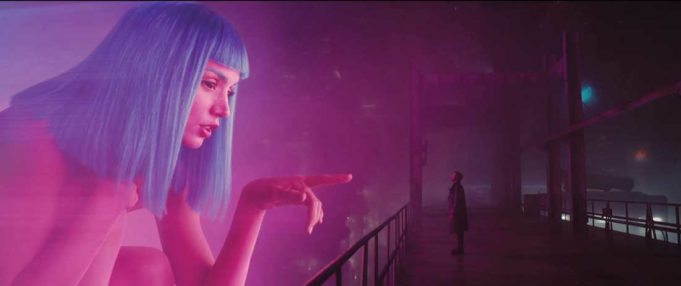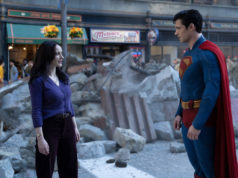The original Blade Runner was a box-office flop when it came out in 1981. Sometimes this gets forgotten about movies that acquire the reputation of a classic, but with Ridley Scott’s science-fiction thriller, it’s remembered pretty well. That’s because the film was chopped up in the editing room by its studio, and Harrison Ford was forced to record some voiceover narration for the new version, in which the star didn’t try to hide how pissed off he was about it. Even in its butchered form, the film gained an audience on home video thanks to its fully realized vision of the future, whose squalid, overcrowded, rain-soaked, corporatized urban vistas have been copied by untold hundreds of hack sci-fi directors lacking Scott’s imagination. Creativity is not a problem but a strong point for French-Canadian filmmaker Denis Villeneuve, who has taken over Blade Runner 2049. That may be the most important consideration. Alas, there are other issues at play to this hotly anticipated sequel’s detriment.
The story picks up 30 years after the events of the original film, when a replicant who goes by the letter K (Ryan Gosling) works for the LAPD as a “blade runner,” hunting down old replicants who won’t obey their human masters’ commands. One job leads him to the skeleton of a dead female replicant who shows evidence of having given birth to a child, supposedly an impossibility for the humanoid robots. K’s superior (Robin Wright) orders him to locate the now-28-year-old baby and kill it as a threat to the established social order. His quest eventually leads him to the aged former blade runner Rick Deckard (Ford), hiding out in the ruins of Las Vegas.
Just like its predecessor, this movie gives you plenty of stuff to look at. Along with cinematographer Roger Deakins and production designer Dennis Gassner (the same team that has collaborated with the Coen brothers on most of their films), Villeneuve recognizably reproduces the aesthetic that Ridley Scott created, right down to the logos for bygone corporate behemoths like Atari and Pan Am emblazoning the skyline. Yet he and his team also expand on that original vision by taking us outside Los Angeles, showing us San Diego turned into a giant garbage dump and Vegas sporting 100-foot statues of naked women posing seductively in the middle of the desert. Deakins does masterful work with the hellish red glow that bathes Vegas, as well as the shifting lights in the lair of Wallace (Jared Leto), the corporate tycoon who creates the replicants, especially in a late scene when he comes up with a novel way of torturing the imprisoned Deckard. Deckard’s hideaway in an abandoned casino, with holograms of Elvis, Sinatra, and Liberace playing music for him, looks like the coolest place to lay low, too.
Unfortunately, screenwriters Michael Green and Hampton Fancher (the latter was also a writer on the original film) also expand on the weakest aspect of the 1981 movie: its philosophical implications. K’s only relationship is with Joi (Ana de Armas), an artificially intelligent pre-purchased hologram companion whose upgrades allow her to feel things on her skin and travel with him outside his apartment. This quasi-romance doesn’t carry near the emotional weight that the filmmakers want it to. Elsewhere, the conversations about what makes the replicants different from the humans pad out this 163-minute film considerably and stop the movie dead in its tracks during a scene between K and a woman who implants the replicants with fake memories (Carla Juri).
The identity of that baby turns out to set up an elaborate misdirection that isn’t worth the payoff. The scene in which Joi tries to have sex with K by hiring a replicant prostitute (Mackenzie Davis) to sync with her hologram looks cool with de Armas’ and Davis’ facial features blending together, but it feels too much like an exercise. It only recalls a similar scene in Spike Jonze’s Her, which covered this movie’s themes more powerfully. Heck, even this past spring’s justly maligned live-action remake of Ghost in the Shell went over this territory more efficiently. Losing that comparison is not a good look.
Villeneuve’s cold virtuosity has been tempered in the past by great performances from his actors, as with Benicio Del Toro in Sicario and Amy Adams in Arrival. The acting here doesn’t rise to that level — while Gosling is quite good at showing volcanic emotions roiling a stoic exterior, he did much the same thing to better effect in Drive. Ford is good here, too, but he comes on quite late in the proceedings. Leto, wearing opaque contact lenses, makes a properly creepy impression as a man who feels up a newly created female replicant while talking about the necessity of slavery. We also get tasty supporting performances by Dave Bautista as a bespectacled fugitive who has a bombshell to drop on K before being terminated, as well as Davis as a sex worker who’s more than she appears to be. These are good to have, but they’re too small to anchor the film.
Even the action sequences here don’t match the ones in the original, or in Sicario, despite the abilities of Gosling, Ford, and Dutch model Sylvia Hoeks as Wallace’s soft-spoken personal assistant who doubles as a hitman. It’s indeed a shame that Blade Runner 2049 doesn’t offer up enough food for thought to go with its visual brilliance. Undeniably, this feast for the eyes is a great movie to project on the back wall of a trendy nightclub. As long as the sound is on mute.
Blade Runner 2049
Starring Ryan Gosling and Harrison Ford. Directed by Denis Villeneuve. Written by Hampton Fancher and Michael Green. Rated R.












